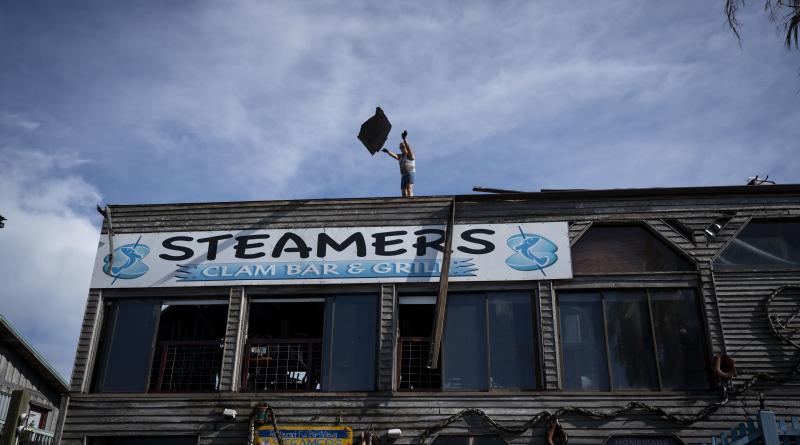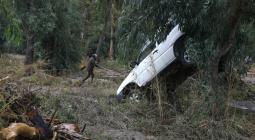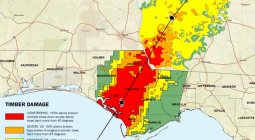Hurricane-Weary Floridians Ask: What U.N. Climate Talks?

CEDAR KEY, Fla.—For this island fishing village along Florida’s Gulf Coast, Hurricane Idalia wrought some of its worst damage not on land but offshore.
Generations of residents of this area have derived their livelihoods from the water, which has remained relatively pristine thanks to several federal and state preserves lining the Nature Coast, as this region is called. As Idalia churned toward the area in late August, Cedar Key was home to a robust clamming community, part of a $53 million industry in the state.
Idalia was the strongest hurricane to make landfall in this part of the state since 1896. The category 3 hurricane came ashore in Florida’s sparsely populated Big Bend region, so-named for how the peninsula meets the panhandle here, packing winds near 120 mph. Preliminary insured losses in the state are estimated at more than $9.6 billion.
In Cedar Key, the hurricane thrust forth a nearly 7-foot storm surge, touching most aspects of life on the island, although the deluge was nothing compared with the rip current Idalia unleashed on the offshore beds of clam farmers like Timothy Solano.
The rush of water forced broken trees and other debris through the delicate beds, tearing them apart. For months afterward Solano and other farmers would search the water by boat for their missing clams. Solano believes his business alone lost some 9.5 million of the mollusks, up to 40 percent of what the business normally would harvest during the following eight to 12 months.
The hardship is the latest challenge for the family-owned business. For the last two summers the clams have suffered in unusually warm water, with temperatures reaching 95 degrees Fahrenheit this past summer. Before that there was an outbreak of red tide, a species of algae that is toxic.
“We see the water rising,” said Solano, part-owner of Cedar Key Aquaculture Farms. “We see it every year. We see the higher tides.”
Yet even as Solano and other Cedar Key residents grapple with the impacts of the changing climate, the global COP28 talks beginning Thursday in Dubai feel more than half a world away.
The talks, convened annually by the United Nations, are aimed at stemming human-caused emissions and meeting the Paris Agreement goal of limiting warming to 1.5 degrees Celsius above preindustrial levels. The talks also are intended to address how nations should divide up the costs of impacts like hotter temperatures, rising seas and more damaging hurricanes. Nearly 200 countries, including the United States, will participate in the talks, which conclude Dec. 12. But Solano is more concerned about problems right in front of him.
“It feels irrelevant to me. I’ve got a lot on my plate right now,” Solano said. “I don’t know what they can do for us.”
One of the Last Working Waterfronts
Floridians are more likely than other Americans to believe climate change is happening and support government actions to address it, surveys show. One recent survey from Florida Atlantic University found that 90 percent of respondents believed climate change was real, compared with 74 percent of Americans who answered similarly on a separate Yale University survey.
The findings of the Florida-focused survey perhaps are not surprising given that 60 percent of the respondents said they had experienced wind-related impacts associated with a hurricane or tornado in the past year, and 45 percent reported negative impacts linked with flooding.
The Florida Atlantic University survey also found that 57 percent of respondents believed in the human-caused nature of climate change. Colin Polsky, founding director of the university’s School of Environmental, Coastal and Ocean Sustainability, said he was considering adding a question to the next survey about the annual U.N. climate talks.
“It’s just one of those things that people don’t even know about. It doesn’t make a lot of news because it’s not generating a lot of forward progress,” he said. “COP, even though it’s not very high on people’s list of things that they think about, it is something that could be transformative on the climate change scene if they were able to come to an agreement.”
Cedar Key is situated some 140 miles north of Tampa in Levy County, where 51 percent of voters favored former president Donald Trump in the 2020 election. Idalia made landfall roughly 100 miles north of here in Keaton Beach. In a state booming with growth and development, Cedar Key has endured stubbornly as an outpost of old Florida.
“It is one of the last coastal working waterfront communities that we have left in Florida. There are not many communities like this one,” said Solano, who lives just across the causeway on the mainland with his pregnant wife, their 4-year-old son and 2-year-old daughter. “It’s still a town where people come, and they make their living everyday. They go out on the water to work.”
The town center consists of a smattering of pastel-painted shops and restaurants and establishments like a history museum, health care center, post office and city hall. Most businesses now have reopened, although a few structures remain boarded up or gutted, their blown-out windows leaving the interiors exposed to the whims of the Gulf of Mexico.
With the supermarket still closed, the nearest grocery store is some 50 miles away. There are no traffic lights, and a lot of people get around on golf carts. Primary draws here are the fresh seafood and stunning sunsets. In this idyllic setting, COP28 feels very far away.
“How do you get people to care? That’s what I wonder,” said Katy Sweeney, who works on the island at ClamTastic Seafood and lives just across the causeway with her kids, ages 4 to 16. “We’re basically at the end of the world. We call it island time, and people feel safe.”
Sweeney is seated on a lavender-painted bench at the heart of a sizable playground featuring a jungle gym, slides, swings and other amenities. Off to her right a small group celebrates a child’s birthday in the shade of a decorated pavilion. To her left a motel remains closed. Behind her the town center bustles with visitors and locals as she stares straight ahead into the water, which laps gently at a white sandy beach. Her daughter runs and plays on the playground with friends.
“The biggest way the hurricane affected this community was the clamming. Some of these smaller farmers, their whole crops got wiped out,” she said. She wore a black ClamTastic T-shirt and her dark hair in a bun, along with a warm smile. “These little guys, a friend of mine, her husband, all his seeds are gone. It’s like he never even planted.”
ClamTastic lost a huge portion of its crop and will be unable to fill several orders, although she felt hopeful the operation would be able to limp along without the loss of too many employee hours. She thought those steering COP28 could do more to engage Americans. Communities like hers need resources to adapt to climate change, she said.
“I watch this place get flooded more and more each storm,” she said as her daughter played. “You do really need money to get these places opened back up. You can’t do it without it. Throwing money at a problem might not solve it, but you’re not going to solve it without it.”
Debbie Franks comes to the playground most days with the 4-year-old boy she helps raise, whose mother lives on the island. Franks and her husband are part owners of a local airport.
“Whatever they decide, it’s going to affect us in every aspect. But you can’t control the water. You can’t control the temperature of that water. So as to what they can do to help our community I have no idea,” Franks said of the COP28 delegates. She was seated on a nearby bench and wore a black-and-white plaid blouse and black jeans as the boy played with friends.
“I think they should take the time to visit different places and see what it’s like and maybe that will give them an idea of what they need to work toward,” she said. “Once you see something and get a grasp on it, then you know how to address it.”
The Last Thing People Are Worried About
Idalia was the most impactful hurricane of an unprecedented season characterized most notably by record warm water temperatures.
The storm forged a path through the Gulf of Mexico over a “maximum of oceanic heat content,” according to the National Hurricane Center. The warmth fueled a rapid intensification of the hurricane, a phenomenon that is becoming more common because of climate change. Before making landfall Idalia reached a peak intensity of 132 mph, briefly pushing the hurricane beyond the threshold of a category 4 storm, defined by winds of 130 to 156 mph.
Throughout the season the water temperatures boosted hurricane activity, shattering several records. At the season’s height, between the end of August and the end of September, a record 13 named storms formed, breaking the previous record established in 2020.
It also was the first time two named storms formed in the Atlantic Ocean so early; Tropical Storms Cindy and Bret both developed in June. In all, the season consisted of 20 named storms, a number that tied with that in 1933 as the fourth-most on record, after 2020 (30 named storms), 2005 (28 named storms) and 2021 (21 named storms). Hurricane season ends Thursday.
Cedar Key Aquaculture Farms is one of Florida’s largest clam wholesalers, selling nearly 25 million of the mollusks to Costco stores along the East Coast. Timothy Solano’s father established the business 28 years ago. Today his brother serves as general manager, his sister as office manager and he supervises all operations on the water. He described the role as a dream job.
“Ever since I can remember as a kid I was on a boat helping my dad,” said Solano, seated inside one of the business’ workrooms. He wore a bright blue shirt and gold chain, and his shoulder-length blonde hair poked out from beneath a baseball cap. “You get to see dolphins swimming next to you and Mother Nature all around you.”
The business’ low-lying facility suffered minor flood damage, although Solano characterized the losses to the clam crop as devastating. A Small Business Administration loan will help, and earlier this month the state legislature agreed to provide $416 million in hurricane relief funding. He said with everything going on people here just are not engaged in COP28.
“That is the last thing people are worried about,” said Solano, who testified before a legislative committee as lawmakers met during a special session to consider, in part, the hurricane relief.
The Point of No Return
Fred Catfish Abbott is a self-described “fishing nut” who had his middle name legally changed from Marshall.
“If there is water and a fish in it I will fish,” said Abbott, a Jacksonville trial lawyer who spends weekends fishing on Cedar Key. He played football back in the day at the University of Florida and gets around town on a golf cart that is orange and blue, Gator colors. The nickname, which he says has little to do with his love of fishing, originated in college.
“When I’m here I usually fish daily and sometimes twice and sometimes three times a day,” he said. “I just like the fact of
It was a mild clear morning in Cedar Key, and the smell of salt lingered in the air. Abbott was seated outside just beyond the town center. He wore a bright orange fishing shirt, and sunglasses dangled from around his neck. He was not surprised that more people here were not familiar with COP28.
“The majority of the people not only in Cedar Key but in this country are struggling to make ends meet. Inflation is out of control. They can’t afford to worry about global warming when they’ve got to worry about paying rent, getting enough food on the table,” he said. He described himself as apolitical and thought the political system was broken.
“We are so close to getting past the point of no return and fouling the net we live in called the Earth,” he said. “It scares me.”





